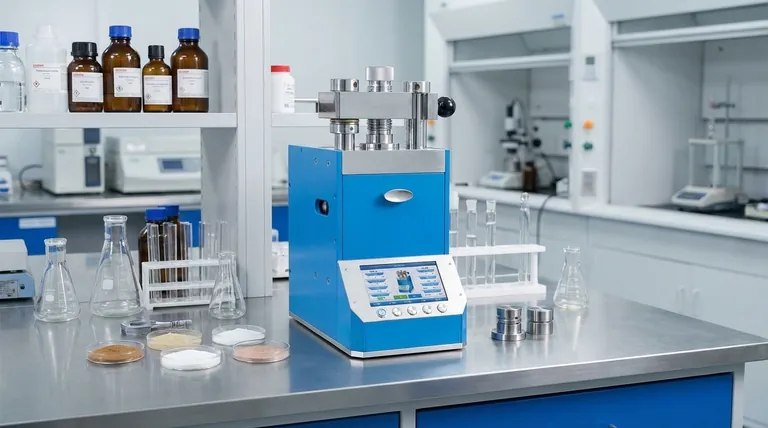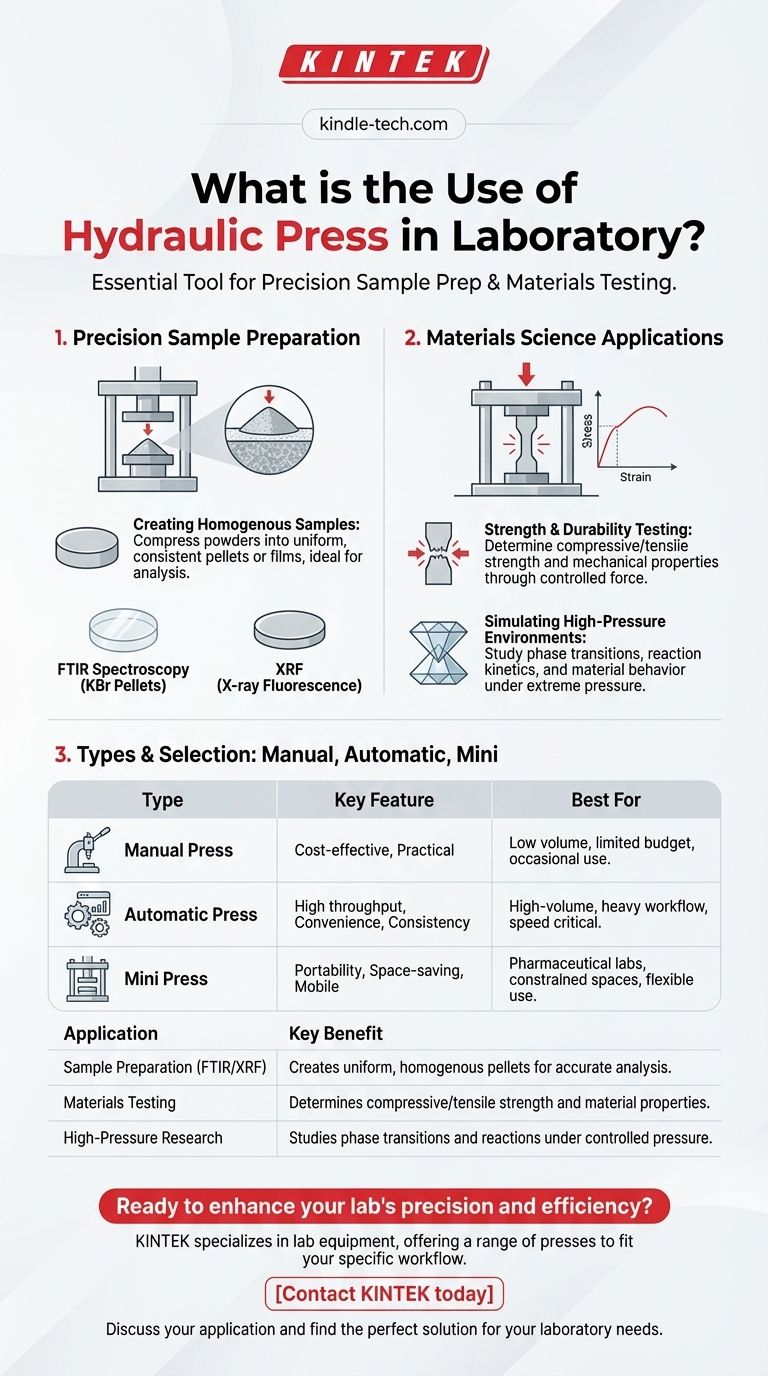In the modern laboratory, the hydraulic press is a fundamental tool used primarily for preparing consistent samples for analysis, testing the physical properties of materials, and investigating the effects of high pressure on various substances. Its ability to apply a significant, controlled force in a compact form makes it indispensable for achieving accurate and repeatable experimental results.
The core function of a laboratory hydraulic press is not just to crush things, but to apply a precise, uniform force. This transforms inconsistent materials into standardized, homogenous samples required for sophisticated analytical techniques and reliable materials testing.

The Core Function: Precision Sample Preparation
The most common application of a hydraulic press in a laboratory setting is preparing samples for analysis. This process is critical for ensuring that the data gathered from analytical instruments is accurate and representative of the material as a whole.
Creating Homogenous Samples
A primary goal of sample preparation is to create a homogenous sample. By compressing powders or other materials into a solid pellet or thin film, the press eliminates inconsistencies and creates a uniform sample density, which is ideal for many types of examination.
Essential for Spectroscopy
This tool is essential for spectroscopic techniques. For Fourier-Transform Infrared (FTIR) spectroscopy, a press is used to create potassium bromide (KBr) pellets, where a small amount of sample is mixed with KBr and compressed into a transparent disc for analysis. For X-ray Fluorescence (XRF), it creates flat, uniform pellets that ensure consistent measurement results.
Beyond Pellets and Powders
Beyond creating standard pellets, a press can be used to prepare powder mixtures for compositional analysis or to create thin films. The objective is always the same: to produce a sample with a consistent form factor that can be analyzed reliably.
Broader Applications in Materials Science
While sample preparation is its main role, the hydraulic press is also a versatile tool for fundamental materials research and testing.
Strength and Durability Testing
Hydraulic presses are used for compressive and tensile strength testing. By applying a measured force until a sample deforms or breaks, researchers can precisely determine the strength, durability, and other mechanical properties of a material.
Simulating High-Pressure Environments
For chemists and material scientists, the press is a gateway to studying how different substances behave under extreme pressure. This allows researchers to investigate phase transitions, reaction kinetics, and changes in material properties in a controlled setting.
Understanding the Trade-offs: Manual vs. Automatic
The choice of press depends entirely on the laboratory's specific workflow, throughput, and budget.
The Case for Manual Presses
Manual hydraulic presses are often more affordable than their automatic counterparts. This makes them a cost-effective and practical choice for labs that do not rely on a high volume of pressed samples or have a limited budget.
When to Choose an Automatic Press
If a lab's workflow is heavily dependent on pressed samples, a manual press can become a laborious bottleneck. An automatic press offers greater convenience and a much quicker pace of work, making it ideal for high-throughput environments where speed and repeatability are critical.
The Role of the Mini Press
A hydraulic mini press offers a unique advantage in portability and space-saving. These small units, weighing only a few kilograms, can still apply around two tons of pressure. They are particularly favored in pharmaceutical labs for their low cost, mobility, and ease of use in constrained spaces.
Making the Right Choice for Your Lab
Selecting the appropriate hydraulic press requires balancing your laboratory's needs for throughput, budget, and application.
- If your primary focus is cost-efficiency and occasional use: A manual hydraulic press provides all the necessary force and precision without a significant capital investment.
- If your primary focus is high-throughput and workflow speed: An automatic press is the superior choice to ensure consistency and reduce manual labor.
- If your primary focus is portability and space savings: A mini press delivers impressive force in a compact, mobile package perfect for flexible lab environments.
Ultimately, choosing the right hydraulic press empowers your lab to prepare samples and conduct tests with confidence and precision.
Summary Table:
| Application | Key Benefit |
|---|---|
| Sample Preparation (FTIR/XRF) | Creates uniform, homogenous pellets for accurate analysis. |
| Materials Testing | Determines compressive/tensile strength and material properties. |
| High-Pressure Research | Studies phase transitions and reactions under controlled pressure. |
Ready to enhance your lab's precision and efficiency?
Whether you need to prepare consistent samples for spectroscopy or conduct rigorous materials testing, the right hydraulic press is key. KINTEK specializes in lab equipment and consumables, offering a range of manual, automatic, and mini presses to fit your specific workflow, budget, and space requirements.
Contact KINTEK today to discuss your application and find the perfect hydraulic press solution for your laboratory needs.
Visual Guide

Related Products
- Automatic Laboratory Hydraulic Press for XRF & KBR Pellet Press
- Laboratory Hydraulic Pellet Press for XRF KBR FTIR Lab Applications
- Laboratory Hydraulic Press Split Electric Lab Pellet Press
- Laboratory Manual Hydraulic Pellet Press for Lab Use
- Laboratory Hydraulic Press Lab Pellet Press for Button Battery
People Also Ask
- What are the disadvantages of KBr FTIR? Key Limitations That Impact Your Data Quality
- How do you prepare a KBr pellet for IR spectroscopy? Master the Key Steps for a Clear Spectrum
- What is a hydraulic press machine used for? From industrial forming to lab sample prep
- Why are KBr pellets used in IR spectrum? Key Benefits for Solid Sample Analysis
- What is KBr disc method? A Complete Guide to IR Spectroscopy Sample Prep



















